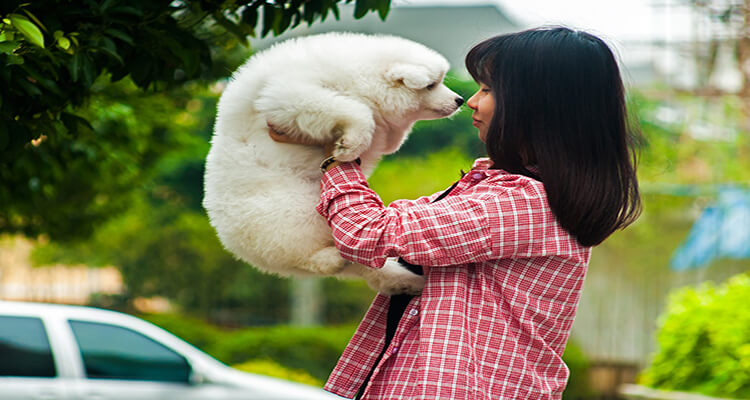The Samoyed is a popular herding and biggest dog origin from Northwest Russia and Western Siberia. It is also known as the “Smiling Sammy”, the people-loving Samoyed is one of the few dogs close to the true dog breed. The Samoyed is part of the Spitz family, is medium-size and fits in well in families.
Samoyed Content overview
- Some Facts
- History
- Different names
- Appearance and Characteristics
- Personality and Temperament
- Health & problems
- How to take care
- Puppy Information
- Puppy price
- Things to consider adopting a puppy
- Advantages & Disadvantages
- Photo gallery
Interesting fact about the Samoyed dog breed
1). Samoyeds Are Stunning Dogs: The Samoyed’s most remarkable feature is her gorgeous, thick white coat. Her eyes are almond-shaped and usually black or brown. Her ears are as furry as the rest of her and stand erect.
2). The Samoyed Is a Generally Healthy Breed: Like all purebred dogs, Samoyeds are prone to certain health conditions, including glaucoma, hip dysplasia, hypothyroidism, diabetes, progressive retinal atrophy, subvalvular aortic stenosis, and cancer. The breed is also predisposed to a condition called Samoyed hereditary glomerulopathy, a genetic kidney disease. The average lifespan of the Samoyed is 12 to 15 years.
3). Samoyed Name Is Often Mispronounced: The breed’s name is correctly pronounced as Sam-a-YED, emphasizing the final syllable. Lovers also know the active and friendly Samoyed of the breed as the Sammy.
4). Samoyeds are one of the oldest dog breeds: The Samoyed breed is thousands of years old and is one of the 14 “ancient dog breeds”—the breeds that modern scientific testing have shown to be oldest and genetically closest to wolves. Most of these 14 breeds, including Samoyeds, are Spitz breeds that originated in Asia.
5). Samoyed Is Sensitive to Heat: As you might guess from her thick, luxurious coat, the Samoyed prefers cooler temperatures. Please don’t allow Sammy to overexert herself in the heat.
History of Samoyed dog
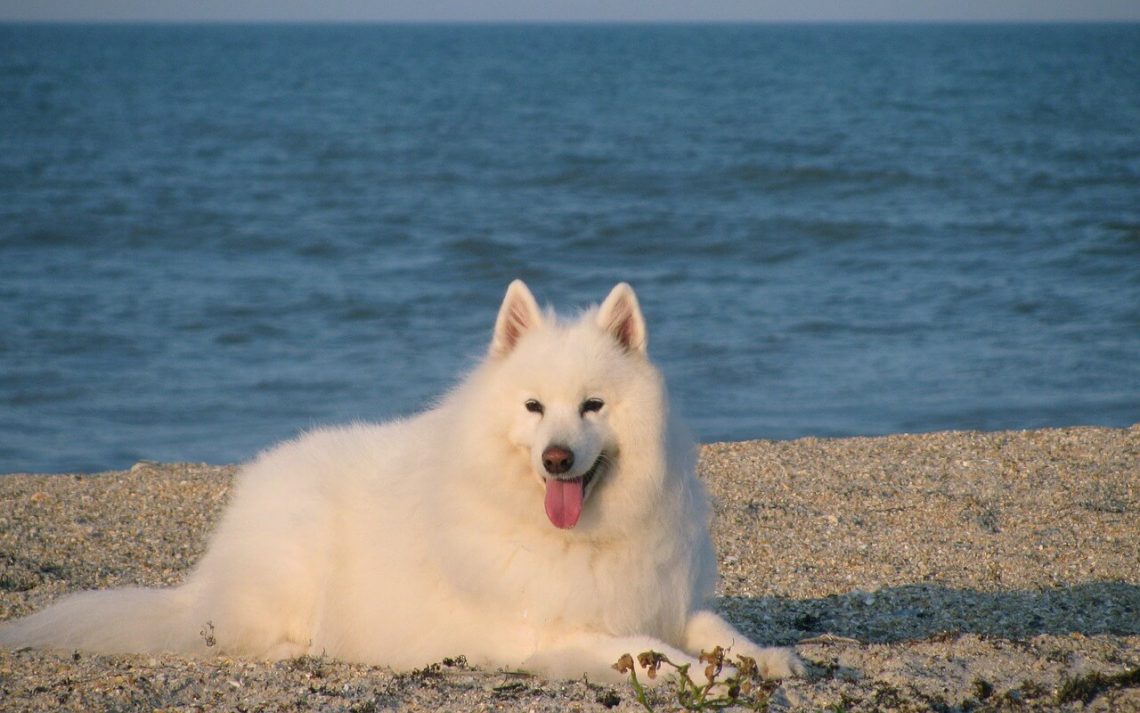
Samoyeds are descended from the Nenets herding Laika, a Spitz-type dog from Siberia used for guarding, sledding, herding and keeping their owners warm. The name Samoyed derives from the Samoyed Tribes in Northern Russia and Siberia. In Southern parts of the area, they used white, black and brown particolored dogs as reindeer herders; in the northern parts, the dogs were pure white, had a mild temperament and were used as hunting and sled dogs.
Most of the Samoyed strain in England and the United States are descended from the veteran expedition sled dogs. The first American Samoyed, a Russian import, was registered with the AKC in 1906.
The Samoyed has been known as a basal breed that predates the modern breeds’ emergence within the 19th Century. During the late 1800s, the breed began to arrive in European countries. However, not all of the first imports were the pure white breed that is common nowadays. One of these early imports was talented to Queen Alexandra; World Health Organization worked exhaustingly to push the Samoyed.
Different names or Types
All names
- Samoiedskaïa Sabaka
- Sami
- Sammy
- Samoyedskaya
Recognized Names
Recognition
- American Kennel Club – AKC
- American Canine Registry – ACR
- Australian National Kennel Club – ANKC
- American Pet Registry, Inc – APRI
- American Canine Association, Inc – ACA
- Dog Registry of America, Inc – DRA
- Canadian Kennel Club – CKC
- Continental Kennel Club – CKC
- Fédération Cynologique Internationale – FCI
- National Kennel Club – NKC
- North American Purebred Registry, Inc – NAPR
- New Zealand Kennel Club – NZKC
- Kennel Club of Great Britain – KCGB
- United Kennel Club – UKC
Appearance & Characteristics
The Samoyed is a medium-sized dog with a heavy and furry appearance. It’s a strong, alert, agile Arctic dog who carries himself with poise, dignity and grace. It’s essentially a working, strong, active and beautiful dog.
This working dog is the epitome of strength and agility as well as beauty and grace. It is compact and muscular with a body that is longer than it is tall.
Breed basic characteristics

Samoyed cutest dog @NSW Samoyed Club
Country of Origin: Northwest Russia and Western Siberia
Size: The Samoyed is a medium-sized dog with a height ranging from 19 to 23 1/2 inches and weight from 50 to 65 pounds.
Lifespan: 12-14 years
Trainability: Responds Well
Exercise Needs: 20-40 minutes/day
Activity level: High
Energy Level: Very Active
Grooming: Weekly
Shedding: Seasonal
Barking Level: Barks When Necessary
Good with Children: Yes
Good with other Dogs: With Supervision
AKC Classification: Working
UKC Classification: Northern Breeds
Hypoallergenic Breed:
Space Requirements: House with Yard
Compatibility With Other Pets:
Litter Size: 4 to 6 puppies
Height/Weight
Height
Males: 21 to 23.5 inches
Females: 19 to 21 inches
Weight
Male: 45 to 65 pounds
Female: 35 to 50 pounds
Sound
Behavior
Size, Proportion, Substance
Size: The AKC Standard requires 21–23.5 inches at the shoulder for males and 19–21 inches for females. The UK Kennel Club Standard requires 20–22 for males and 18–20 for females.
Proportion:
Substance:
Serious Faults:
Head
Head powerful and wedge-shaped with a broad, flat skull, muzzle of medium length, a tapering fore faces not too sharply defined.
Skull: Viewed from the front and in profile only slightly convex. Broadest between the ears. The slightly visible furrow between the eyes.
Muzzle: The muzzle is in proportion to the size of the dog, tapering to the nose.
Eyes: Samoyed dog eyes are usually black or brown and are almond in shape. Blue or other color eyes can occur but are not allowed in the show ring.
Ears: Samoyed ears are thick and covered with fur, triangular in shape, and erect. They are almost always white but can often have a light to dark brown tint, usually around the ears’ tips. Ears should conform to head size and the size of the dog.
Teeth:
Serious Faults: Yellow eyes, Light bone.
Neck, Topline, Body
Neck: Strong, well-muscled, carried proudly erect, set on sloping shoulders to carry head with dignity when at attention. The Neck should blend into shoulders with a graceful arch.
Topline:
Body: It has a strong, muscular body that can combine power, speed, agility and endurance. Slightly longer than the height at the withers, deep and compact but supple.
Chest: Broad, deep and long, reaching almost to the elbows. It Should be deep, with ribs well sprung out from the spine and flattened at the sides to allow proper movement of the shoulders and freedom for the front legs.
Serious Faults: Clearly unpigmented areas on eye rims or lips.
Forequarters
Legs ought to be parallel and straight to the pasterns. However versatile with some spring for the correct let-down of feet, the pasterns ought to be robust, durable, and straight. Due to the depth of the chest, the legs ought to be moderately long. Length of the leg from the bottom of the elbow ought to be around 55 percent of the full height at the withers-a short-legged dog is to be deprecated. Out at the ought tours or out at the elbows should be fined. The withers separation ought to be around 1 to 1½ inches.
Shoulders: Shoulders ought to be long and sloping, with a layback of 45 degrees and be firmly set.
Forelegs:
Front Feet:
Hindquarters
Upper thighs ought to be developed. Stifles well bent-approximately 45 degrees to the bottom. Hocks ought to be developed, sharply outlined and set at roughly 30 % of hip height.
Rear Legs:
Hind Legs: The hind legs should be parallel when viewed from the rear in a natural stance, strong, well developed, turning neither in nor out.
Tail: The tail is moderately long, well-covered with hair carried rolled on the back.
Coat
The Samoyed is a double-coated dog. The body should be well covered with an undercoat of soft, short, thick, close wool with longer and short hair growing through it to form the outer coat, which stands straight out from the body and should be free from curl.
Winter Coat:
Summer Coat:
Shedding:
The Samoyed coat can also mat and needs to be brushed weekly, more often during shedding season. Extensive grooming is needed. They are seasonally heavy shedders. The fluffy double coat needs frequent brushing but tends to stay white without bathing.
Color and Markings
Pure white, cream or white with biscuit. Should never give the impression of being pale brown.
Coat Color and Markings
The Samoyed has a double coat, the undercoat being wool, which, when carded and spun, can be woven or knitted into beautiful clothing. It is strong and warm. The coat is odorless, the outer coat is coarse, long, and the tips have a silver glint. Both coats should stand out from the body; a drooping coat is not typical of the breed. The color is white, cream, or white with biscuit highlights.
Gait: Powerful, free and tireless in appearance with a long stride. Good reach in the forequarters and good driving power in the hindquarters.
Samoyed dog costumes
Personality and Temperament of Samoyed
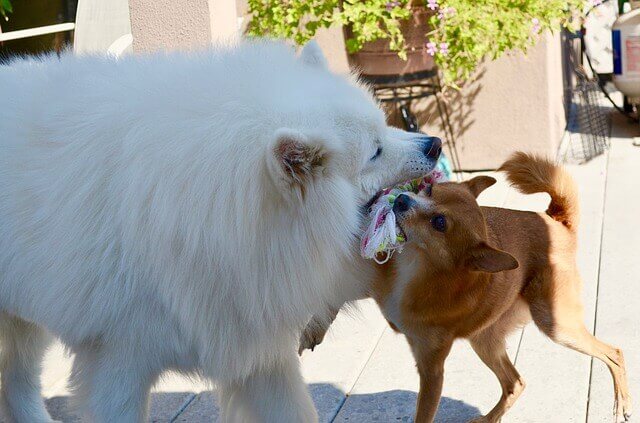
Personality
The Samoyed is a very good personality dog breed in the world. It’s a friendly and personable dog. They are excellent companions for people who like the outdoors. Samoyeds are always up for a good hike in the woods and will be happy to keep you warm overnight on a camping trip. They can be difficult to train, but summers are generally well behaved and make a great choice for first-time dog owners.
Temperament
Temperament is a very important aspect of the Samoyed breed. The Samoyed, known as the smiling dog, is an intelligent and gentle breed that bonds closely with its family. It is friendly towards other pets and prefers to play with children, although it may tend to her younger kids.
Samoyeds are usually good with other animals, but with strong chasing and herding instincts, they may take off after trespassing cats or wildlife.
Activity Requirements
Samoyeds would like a moderate quantity of vigorous activity to take care of health and happiness. The wintertime is their favorite time of year, and you’ll be able to make certain your Sammy can entertain himself for hours within the snow, particularly if he has kids to play with it. While not snow, you’ll be wanting to steer your Samoyed many times every day and permit him to stretch his legs and run many times per week, particularly as a puppy. If a Samoyed doesn’t get enough exercise, he can allow you to grasp by manuduction your personal possessions.
Behavioral Traits
Teaching your Samoyed to obey commands to stop barking can minimize the annoyance, but it is very hard to train this behavior out of a Sammy. Samoyeds were raised to be contributing members of the Samoyeds tribes of Siberia.
Trainability
The intelligent Samoyed dog is willful and mischievous in the area of dog training. It would help if you were dominant and consistent enough to convince the puppy that you’re the alpha of the home. Though they love people to pieces, Sammies don’t always like to listen, and training can be challenging. Sessions should be kept short to maintain the dog’s interest, and activities should be varied.
Health & problems
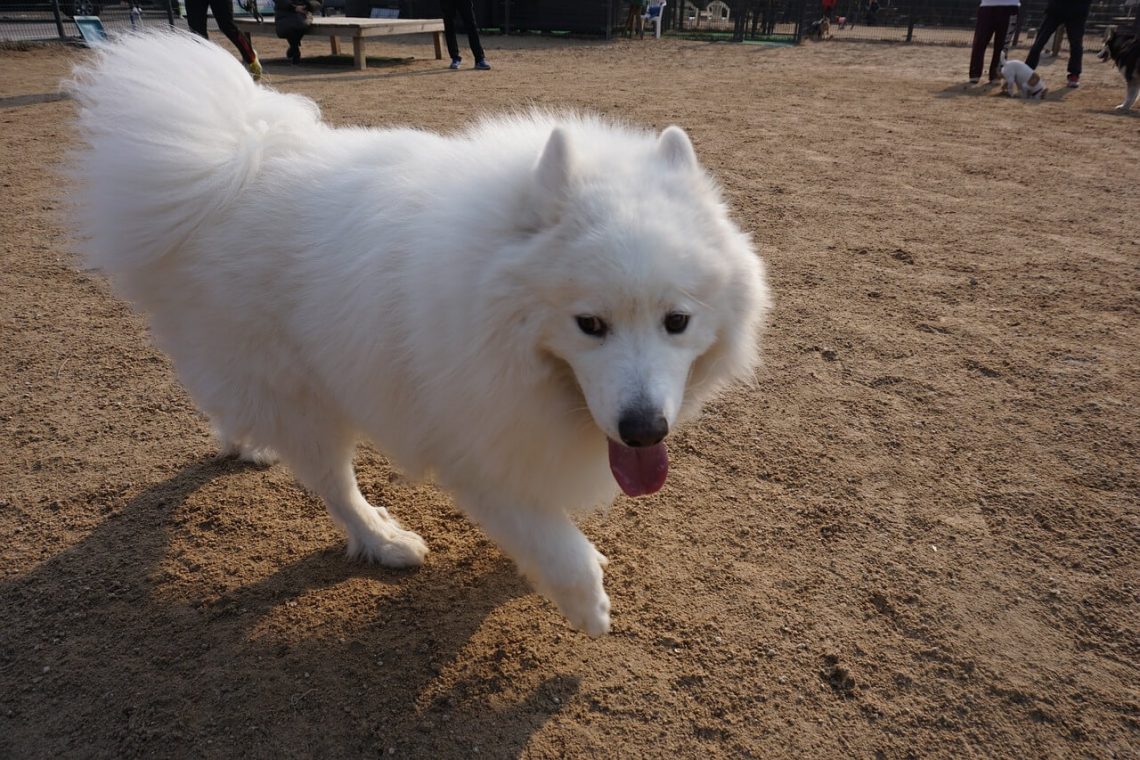
Health
Like All dogs, Samoyed has the potential to develop genetic health problems. Samoyeds are generally healthy dogs, but all breeds have problems that must be recognized and then dealt with sensibly.
Health Problems
The Samoyed is generally healthy, but Some health problems are inherited. For example, eye diseases, heart diseases, and hip dysplasia etc. But not all Samoyeds will get any or all of these diseases, but it’s important to be aware of them if you’re considering this breed.
Some health issues for Samoyed
Obesity: can be a significant health problem in Samoyeds. It is a serious disease that may cause or worsen joint problems, metabolic and digestive disorders, back pain and heart disease.
Bone and Joint Problems: Several different musculoskeletal problems have been reported in Samoyeds. While it may seem overwhelming, each condition can be diagnosed and treated to prevent undue pain and suffering.
Infections: Samoyed is susceptible to bacterial and viral infections that all dogs can get, such as parvo, rabies, and distemper.
Best food for Samoyed dog
Feeding Plan
Depending on your dog’s size as an adult, you are going to want to feed them a formula that will cater to their unique digestive needs through the various phases of their life. Many dog food companies have breed-specific formulas for small, medium, large and giant breeds. The Samoyed is a medium l breed and has a lifespan of 12 to 14 years.
- Samoyed pups between eight and twelve weeks old need four meals in a day.
- Feed Samoyed pups three to 6 months old 3 meals in a day.
- Feed puppies 6 months to 1 year two times every twenty-four hours.
- By the time your Samoyed hits her first birthday, 1 meal every 24 hours is usually sufficient.
- Sometimes adult Samoyeds might eat 2 smaller servings. It’s your job to learn your Samoyed’s eating habits.
Living conditions
Samoyeds can easily adapt to small spaces, especially if they get sufficient exercise in a moderate-sized yard. They do not do well if left alone for long periods. Samoyeds usually alarm bark but then greet the stranger with a wagging tail and tongue.
How to take care of the Samoyed
Providing enough exercise
Exercise is very important in every dog’s life. Samoyeds must have regular opportunities to vent their energy. Otherwise, they will become rambunctious and bored, which they usually express by non-stop barking and destructive chewing.
This dog breed has average exercise needs that must be met on a day-to-day basis. You may walk your dog, let your dog jogging with you, or leave the puppy to engage in vigorous play within the yard.
Grooming & Bruising
Samoyed needs regular grooming to ensure their thick coat stays healthy and matt-free. This canine has a double-coat, which will need weekly, even daily, brushing. If you or anyone from your household suffers from allergies, keeping a Sammy might trigger attacks. The breed sheds heavily, and you need to keep up with coat care. It is not among good dogs for people with allergies.
During shedding periods, daily brushing is a must. On other days, 2 to 3 combines a week will suffice. You may also use the cloth to wipe away dirt from their coat. To prevent allergies, remember to blow-dry the coat after a shower.
Dental Health Check-up
Dental health is an important part of your dog’s overall wellness and should not be overlooked. This is even more so if you own Samoyed, who are more prone to dental problems than some breeds.
Dental disease is the most common chronic problem in pets, affecting 80% of all dogs by age two. And unfortunately, your Samoyed is more likely than other dogs to have problems with her teeth. It starts with tartar build-up on the teeth and progresses to infection of the teeth, gums and roots. So dental health check-up is very useful for your dogs or puppies.
Love & affection
Love and affection are useful for every dog. Suppose you give love and affection to your Samoyed, then the dog will love you back. Your Samoyed puppy will be a member of your family, So Give lots of love and affection to your cute puppy. Most importantly, spend time with your dog because that your dog needs love and affection.
Feed Healthy food
Feeding a healthy meal in the dog’s life is the most important. On this day, many healthy foods are available in the market so that you can choose any healthy food for your dog. Healthy food is the most important for dog health care. The young Samoyed, in general, is not a hearty eater as most breeds his size. He must often be encouraged with meat juices or bacon grease mixed in the food to entice him to eat.
What food best for Samoyed dog?
- Merrick Grain Free Real Chicken & Sweet Potato Dry Dog Food
- Fromm Adult Gold Dog Food
- Victor Yukon River Salmon & Sweet Potato Grain-Free Dry Dog Food
- New Formula- ACANA Grasslands Regional Formula Grain Free Dry Dog Food
Avoid toxic foods
Toxic foods are detrimental to every life, so it is important to know which foods are harmful to your Samoyed puppies. Currently, many foods are useful for humans, but they are toxic to Sammy’s dog. Many toxic foods are like grapes, Alcohol, Nuts, beer, raw bread dough, chocolate, garlic, and onions. Any other foods are included in a toxic food, so don’t feed these types of food to your lovely puppy.
Puppy information
Samoyed puppies for sale
Finding the right Samoyed puppy can be dog-gone hard work. Puppy Find provides a convenient and efficient means of selecting and purchasing the perfect Samoyed puppy (or Samoyed puppies) from the comfort of your home, 24 hours a day, 7 days a week.
Samoyed Puppy Training
Samoyeds are extremely friendly, playful and good with children and devoted to their owners, making them good family dogs. The Samoyed is a high-energy breed. You’ll have to approach Samoyed training in a slightly different way because of that energy than you would another breed.
Crate training for Samoyed
Crate training can also help teach desired behavior, reduce separation anxiety, Fill the crate with comfortable bedding and a few toys.
Puppy crate training is a great way to manage the safety and well-being of Samoyed puppies. Crate training is one of the most important things you can do for your new dog. It’s served many purposes. Crates should be large enough for the adult dog to stand, sit and stretch out.
Crate training is a very challenging part of owning a puppy, but this dog is very intelligent and a few training sessions should do the trick of getting your dog house trained.
Behavioral training
Behavioral training is very important for any dog. All of us, dog owners, need to administer some dog behavior training at some point in time. Behavioral training is very helpful for taking care of the dog. If you want to train your Sammy puppy to Behavioral training, find out some common behavioral issues like briking, aggression, food guarding, howling, mouthing and chewing, separation anxiety, etc, stop these behavioral issues and train your dog easily.
Obedience training
This is one of the basic and most important training for any dog. There are 3 methods that you can use with your Samoyed; all begins with a strong foundation in the core 5 obedience commands: come, sit, stay, heel, down. Every dog should know these 5 basic obedience commands Because it is very necessary for obedience training.
The average cost of a Samoyed puppy is going to fall between $675 and $1,300
Find a breeder
Now that you have narrowed your search for a dog to the Samoyed, you will need to find a responsible breeder with whom you feel comfortable.
Samoyed Rescues
Samoyed Only Rescues in North America
These websites and groups are excellent resources for information on adopting a Samoyed.
- Samoyed Rescue of Utah – www.utahsams.com
- MidAtlantic Samoyed Rescue – www.samrescue.com
- Wonderland Samoyed Safe Haven – www.wssh.org
- Arizona Samoyed Rescue – www.azsammyrescue.org
- Northern Illinois Samoyed – www.nisasamoyedrescue.org
- San Francisco Samoyed Rescue – www.sfsr.org
- Denver Samoyed Rescue – www.denversamoyedrescue.org
- St. Louis Samoyed Rescue – www.stlsamrescue.org
Things to consider adopting a Samoyed
If you’re seriously considering adopting a Samoyed, you should know.
- Before you adopt a Summy, consider how much time your new family member will spend alone. Remember, a puppy requires constant attention.
- Samoyeds puppies are super cute, but simply put, puppies can be adorable, relentless machines of destruction.
- Before you adopt a puppy, ask yourself if you can walk your dog several times throughout the day.
- You also have the advantage of knowing that your dog is physically able to “hold it” for several hours at a stretch.
- Ask anybody who has adopted an adult dog then adopts an adult dog.
- If you’re unsure whether the new dog you’ve chosen is right for your family and lifestyle, consider fostering before committing.
Advantages of Samoyed Dog
- Beautiful, loving, fun dog
- Constant smiling face and their playfulness
- Samoyed’s are sweet-tempered, intelligent, and dignified family dogs.
- If you live in a cold climate, they help keep you really warm in the winter.
Disadvantages of Samoyed Dog
- Samoyeds can be quite stubborn.
- They just get distracted too easily.
- Training can be challenging with all northern dog breeds, and Samoyeds in particular.
- They shed a lot, so sometimes your living room will have white tumbleweeds rolling across it.
Photo gallery

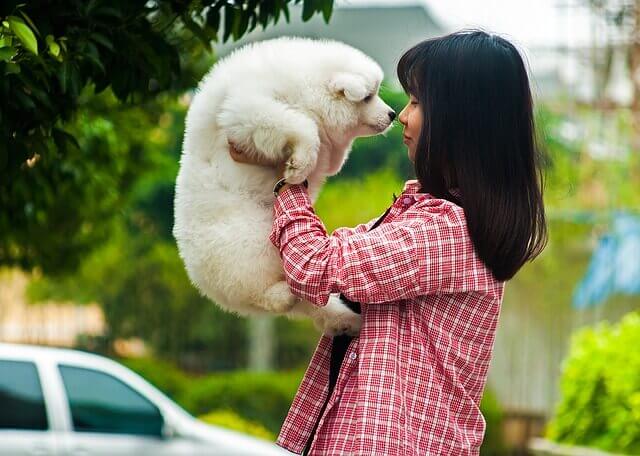
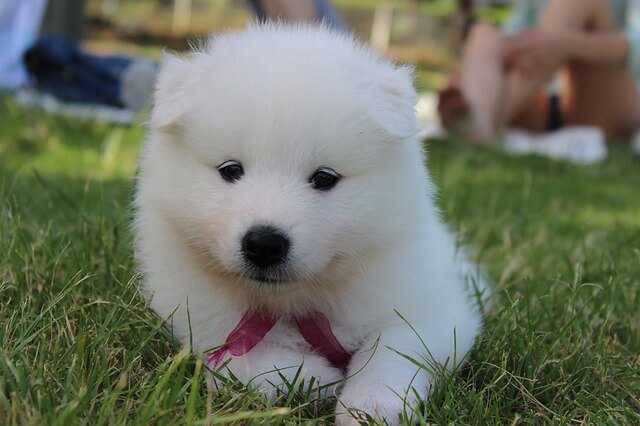
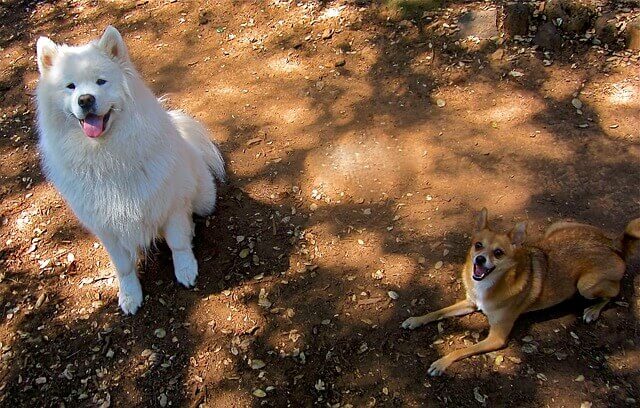
Done. I tried to include maximum information in this post. Please like and share if you like this post. If you have any information about Samoyed dog, then send me via the contact form or comment below.
References
wikipedia.org
dogtime.com
www.akc.org
yourpurebredpuppy.com
dogbreedinfo.com
vetstreet.com
petwave.com
